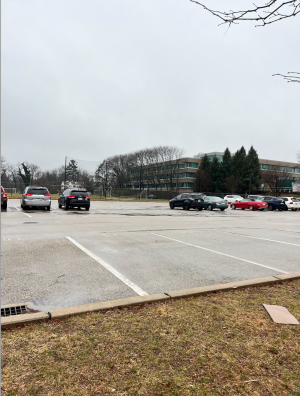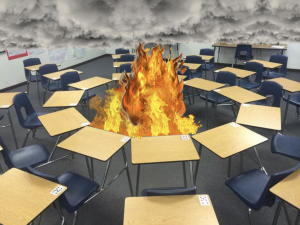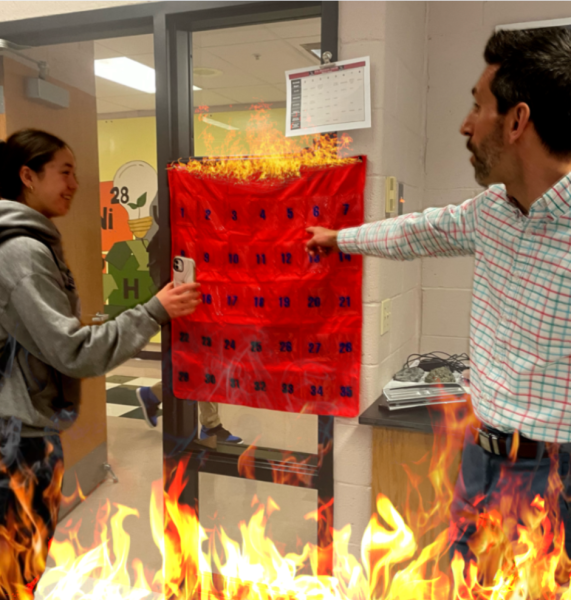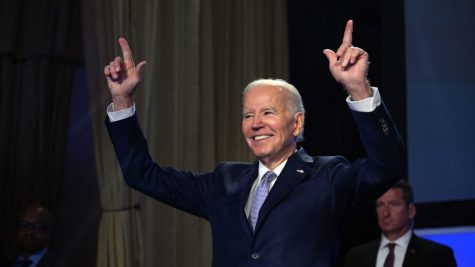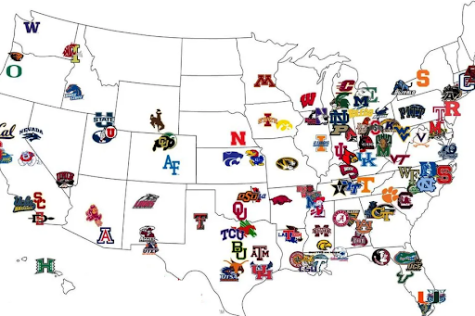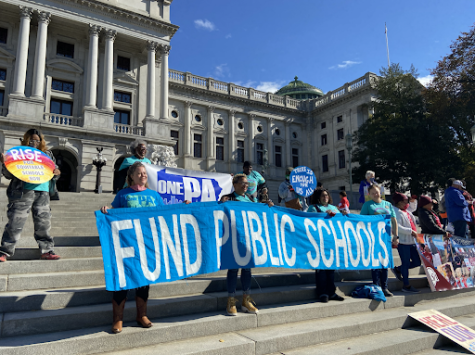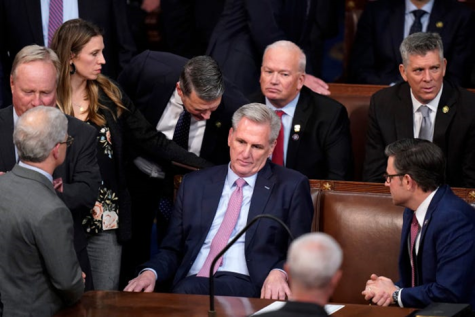A Break Down of the Midterms for the Uninformed
November 5, 2018
On November 6th 2018, only one day away, Americans in every state will be able to vote in the Midterm Elections, which occur two years after every presidential election. These elections will determine all 435 seats of the U.S. House of Representatives and ⅓ of the U.S. Senate, as well as local city mayors and 39 state or US territory governors.
While every vote cast on each person’s ballot specifically pertains to their state or district, the outcome of the votes will ultimately shape the direction of this country for the next two years.
The majority of Americans struggle to keep up with the politics of the Midterm Elections due to the vast number of political candidates running. This year, some of our seniors will be voting for the first time. As we are young citizens of the United States, the future of our government will have a great impact on our lives ahead. It is crucial that we cast our votes, with developed understanding, so we can begin to direct the future of America. This article is intended to not only help our Senior voters but to provide everyone with an outline of the implications our votes will have on the Radnor community and the national government.
Congress
The outcome of Congress will have a vital impact on the future of our government. Divided into two chambers, the House of Representatives and the senate, Congress functions as the legislative branch of government. Congress can ratify bills and create federal law. Therefore, the people we elect into Congress will guide the legislation of our country over the course of the next few years.
The 435 members of the House of Representatives are directly elected by the people and are constitutionally intended to represent the public. The number of representatives in the House is determined by the state’s size; Pennsylvania will be reelecting 18 members. The House also has the power to initiate impeachment and produce bills to be passed as laws. Historically, members of the House tend to support legislation that benefits their district over their party due to their short-lived term and the frequency of the Midterm Elections. According to Nate Silver’s FiveThirtyEight blog, during the week of Kavanaugh’s confirmation, the chances of the Democrats taking over the House improved from 3 in 4 to 4 in 5.
Every state is divided into districts that will elect one representative each into Congress. In Radnor, we are a member of District 5 and are voting for a representative into the House. The candidates who are running are Mary Gay Scanlon, a Democratic politician and attorney, and Pearl Kim, a Republican special victims prosecutor. Our district lines have recently been redrawn; a 2018 Pennsylvania Supreme Court case determined the state’s districts to be unconstitutionally gerrymandered.
The Senate has similar powers as the House with only slight variations, such as having the ability to conduct impeachment trials, holding power over other branches of government by being able to appoint and reject government positions and filibuster, and being able to delay or debate legislation from passing.
In order to maintain the majority and hold the power in Congress, a party needs to hold 51 or more seats to win the Senate and 218 seats to win the House. The winning party will be able to pass the most amount of their own legislation.
Trump’s administration and those in favor of his administration are relying on a Republican majority in order for his agenda to further impact the country’s laws. However, since Day 14 of Trump’s’ presidency, his administration’s approval rating has been dwindling below 50%. Many Americans are depending on the Midterm Elections to limit the conservative legislation that Trump is pushing through Congress.
A Democratic Win
Currently, the country is expecting a Democratic win in the House and possibly the Senate. This is largely based on the fact that, historically, Midterm Elections go towards the opposite party of the presidential administration. Theoretically, this is due to the dissatisfaction that many Americans may feel in regards to the President’s actions, as well as the urgency of the opposing party to get out and vote, the so-called enthusiasm gap.
In the U.S House of Representatives, there will most likely be a Democratic win. Reports expect an 80% chance of a Democratic majority. Few news sources are doubting this outcome.
In the Senate, however, the race for a Democratic majority is less certain, and the polls will have to show a staggering majority to win. With 33 seats up for grabs in the Senate, Vox News explains that “Democrats will still need to win most or all of West Virginia, North Dakota, Missouri, Montana, Indiana, and Florida — and then win the Republican-held seats in Nevada, Arizona, and maybe even Tennessee or Texas— in order to win the 51 seats they need.” One source predicts a ⅕ chance of a Democratic majority, and numerous others who have analyzed every Senate race predict that the Democrats will not be able to secure the Senate.
Future Legislation:
The implication of a Democratic win is a divided government. The legislative branch will be majority Democratic, with the opposing executive branch being Republican. Even though Democrats would not have full freedom moving forward, if they win they will still have more power than they do today. A win for the Democrats may allow them to investigate Trump’s administration, block Trump’s future nominees, win many offices with the 2021 redistricting power, and pass liberal laws in many parts of the country. Trump’s power and influence will be checked and his controversial bills, such as immigration policies, will be unlikely to become law.
A Republican Win
If the Republicans retain control of both the House and the Senate during the Midterm Elections, the country will most likely be shocked. Coverage has been focusing on how many Americans will be voting Democrat, in order to rein in the President’s executive actions and investigations, as well as increase the possibility of impeachment. However, if younger adults and Latinos, who often lean left, turn out in low numbers on November 5th as they have done in previous midterm elections, and if Republicans unite to vote for Republican congress(wo)men, then the likelihood of a Republican majority in both the House and Senate increases.
A full win, meaning both a House and Senate majority, will not only allow for more of Trump’s conservative legislation to be pushed through, but it will also boost Trump’s confidence. As New York Times writer David Leonhardt explained, “it would be validation for Trump, who could then brag that he had defied the experts once again. It would mean he had outperformed Barack Obama, Bill Clinton, Ronald Reagan, Lyndon Johnson and Harry Truman, all of whom suffered drubbings in the first midterm election of their presidency.” While the precise implications of this confidence remains unknown, we can assume that Trump would use this advantage to boast his successes.
Future Legislation:
Over the next few years, the possible legislation that could be passed through Congress by Trump includes stricter immigration laws and limited abortion rights if Roe v. Wade is revisited. In an effort to continue the booming economy under a Republican-majority government, the Senate will probably revise the NAFTA deal to best benefit American consumers, even at the expense of negotiations with Canada and Mexico. The Trump Administration’s goal to lower the trade deficit between the United States and Mexico will make North America a more competitive power in the global marketplace. A red Senate will want to further negotiate with Mexican state-owned companies to start operating like private businesses, which is a source of tension due to Mexico’s national pride in their public businesses. In addition, support for “snapback” tariffs, a tax imposed if domestic industry was damaged by imports, would likely increase. This is another source of tension, as critics claim the tariffs are already stated in the original NAFTA deal. Finally, the Senate would likely push for the end of the maquiladora program, which allows US companies to assemble finished products across the border in Mexico. These factories are low-cost and can then be exported back to the United States. Maquiladoras are responsible for 65% of Mexico’s exports and 30% of the workforce, which is why Mexico is unlikely to shut down the program. The NAFTA deal is inadvertently improving the program but eliminating trade tariffs, which Republicans are disappointed with.
House Republicans tried to pass a bill this summer addressing the mess that is the American immigration system; however, it was quickly shot down. Parts of the bill, including putting 25 billion dollars towards strengthening border control, will likely pushed by a red Senate.
“House Republicans should pass the strong but fair immigration bill, known as Goodlatte II, in their afternoon vote today, even though the dems won’t let it pass in the senate. passage will show that we want strong borders & security while the dems want open borders = crime. Win!” Trump tweeted.
This tweet predicts the future regarding immigration with the reversal of current power, that is, a Democratic House and Republican Senate.
A Divide of Power
The most likely situation, based on the media’s predictions, is that the Democrats will win the House and the Republicans will win the Senate. However, it will give Democrats more power in Congress than they currently have. Democrats will be able to stop any major controversial legislative, and also advance some of their own interests. This environment will provide a more integral checks and balance system to the government.
However, the trend of these two branches of our Congress moving in different directions will cause tension that will inhibit future change. The reason behind this is that, typically, the people voting for representatives for the House are much more educated and have more knowledge on who they’re voting for than those voting for the Senate. The House is supposed to represent the people and reflect personal, more local politics. With the Senate, it usually just boils down to your party. Here we see that common expectation that rural areas will vote red being realized.
Recent factors that have been in the news the last few days will most definitely have an impact on voter turnout and their votes. The booming economy is one factor that could make voters lean right. However, there are many other events that will possibly bring more Democrats to the polls next Wednesday. These include the recent pipe bombing, the US government’s handling of the Brett Kavanaugh case, and the weapon negotiations with Saudi Arabia.
Due to our political climate, the 2018 Midterm Elections are some of the most important elections we have lived through. The intensity of these elections has created an environment that calls for all Americans to change the current state of national and state politics. This year, we have seen more women, youth, people of color, and others run for office than ever before. Pennsylvania has only ever elected 7 women into the US House of Representatives. This year, however, there are 8 female candidates for congress. Two of them, Pearl Kim and Mary Gay Scanlon, are our candidates for District 5’s congressional representative. The 2018 Midterm Elections are not just about partisanship, but rather a new age of diverse and open minded politicians.
Our Candidates
Senate:
Bob Casey (D) – https://bobcasey.com/
Lou Barletta (R) – http://www.loubarletta.com/
Neal Gale (Grn) – https://www.gale2018.com/
Dale Kerns (L) – https://dalekerns.com/
House of representatives (District 5):
Mary Gay Scanlon (D) – https://www.scanlonforcongress.com/
Pearl Kim (R) – https://www.pearlkimforcongress.com/clean_up_the_mess
Governor of Pennsylvania:
Scott Wagner (R) – https://wagnerforgov.com/
Tom Wolf (D) – http://wolfforpa.com/
Ken Krawchuk (L) – https://www.kenk4pa.com/
Paul Glover (Grn) – http://paulglover.org/governor
Lieutenant Governor:
John Fetterman (D) – http://www.johnfetterman.com/
Jeff Bartos (R) – https://www.facebook.com/BartosForPennsylvania/
Jocolyn Bowser-Bostick (Grn) – http://www.facebook.com/green4justiceandtruth/
Kathleen S. Smith (L) – http://www.facebook.com/kathy4ltgov/
State Senate
Many State Senators of Pennsylvania are being reelected. The Radnor community’s primary district, District 5, is not reelecting. Find out if your district is voting – https://ballotpedia.org/Pennsylvania_State_Senate_elections,_2018
State House (District 165):
Jennifer O’Mara – https://www.voteomara.com/
Alexander Charlton – https://www.charltonforpa.com/
State House (District 166)
Greg Vitali (D) – http://www.votevitali.com/
Baltazar Rubio (R) – https://www.rubio166.com/
Sources
https://projects.fivethirtyeight.com/trump-approval-ratings/
https://www.nytimes.com/2018/10/19/opinion/sunday/midterm-elections-republican-party-trump-senate-house.html
https://projects.fivethirtyeight.com/2018-midterm-election-forecast/senate/
https://www.politico.com/election-results/2018/house-senate-race-ratings-and-predictions/
https://whyy.org/articles/pa-women-poised-to-make-history-in-congressional-delegation-after-primary-victories/
https://fivethirtyeight.com/features/is-kavanaugh-helping-republicans-midterm-chances/


